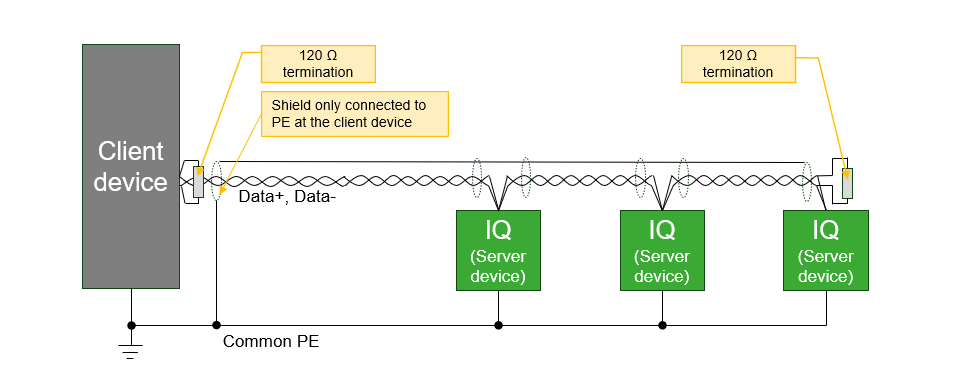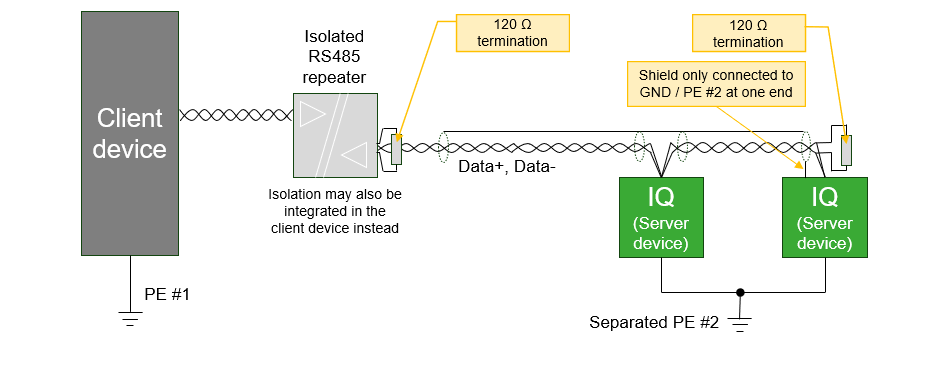Modbus introduction
The ECOSTAR controller has in total 3 built-in Modbus RTU interfaces.
1. CN7 A1/B1: VARISPEED frequency inverter
This interface is for the VARISPEED or VARIPACK frequency inverter, wired ex-factory and will not be further described.
2. CN7 A2/B2: external display or network mode
This interface is for the optionally available external display and/or the network mode.
External display (LUP200)
The display will be auto detected when connected. A shielded twisted-pair cable is recommended.
ECOSTAR network mode
The network mode can be used when 2 .. 4 ECOSTARs are used in the room temperature mode for one cold-store room.
With the BEST Software or web interface, the client device and server device controllers must be defined. The main settings of the client device will be transferred to the server devices automatically. Afterwards all ECOSTARs can be monitored via the client device controller by using BEST or the web interface.
Wiring:

M1: ECOSTAR defined as client device
S1, S2, S3: ECOSTARs operating as server devices
R1, R2: 120 Ohm terminating resistors at each end of the Modbus line
3. Port between the ethernet and USB plugs:
Superior system controller or building management system
This interface allows to monitor the condensing unit as well as to perform parameter changes via a superior controller or a building management system.

Configuration of the Modbus communication parameters
Configuration and default settings can be found in BEST under "Configuration" in the parameter group "Communication". Parameters can be set via BEST using mini-USB cable or Bluetooth. A change of communication parameters will result in immediate changes of the communication.
Used data types and scaling
Data types:
- uint8: unsigned 8-bit integer
- int16: signed 16-bit integer
- uint16: unsigned 16-bit integer
Scaling of the values:
- Scale 1: The value is the exact value
- Scale 100:
- To transmit a value, it must be multiplied by 100, i.e. 1.23 --> 123.
- A received value must be divided by 100, i.e. 123 --> 1.23
Modbus function codes
The following function codes have been implemented from the standard Modbus protocol:
Function | Code (hexadecimal) | Code (decimal) | Remarks |
|---|---|---|---|
Read holding registers (H) | 03 | 03 | |
Read input register (I) | 04 | 04 | |
Write multiple registers (H) | 10 | 16 | |
Read/write multiple registers (H) | 17 | 23 | Can also be used for writing single registers |
All input registers can also be read as holding registers.
Modbus exception codes
The following exception codes have been implemented from the standard Modbus protocol:
Code | Name | Meaning |
|---|---|---|
01 | Illegal function | The function code is not valid. |
02 | Illegal data address | The specified register is not valid. |
03 | Illegal data value | The value is not allowed. |
Wiring recommendations
- The cable must be shielded, twisted pair suitable for RS485 communication with a recommended characteristic impedance of 100 .. 130 Ω. The two signal wires must be in the same pair of wires.
- The wiring topology must be daisy chain with 120 Ω termination resistors at each end of the bus line. As this IQ product has no integrated termination resistor, it must be added externally.
- The maximum possible cable length of the Modbus line depends on the used baud rate and the number of devices.
- The Modbus cable should be routed so that the influence from the power cables is minimized. When crossing power cables, a 90° angle should be achieved. Modbus and power cables that run in parallel should be separated by the largest possible appropriate clearance distance, approximately 20 .. 25 cm. A grounded shield plate or grounded metal duct can be used instead.
- The maximum recommended number of IQ products on one Modbus line is 10 devices. If other equipment is connected to the same Modbus line, the maximum current sourcing of the other equipment must be observed. The total bias resistance of the complete string should be at least 450 Ohm. This IQ product has a bias resistance of 10 kOhm (→ 1 kOhm with 10 units).
- This IQ product has no galvanic isolation in the RS485 interface. Therefore, modules connected directly by RS485 bus must share the same PE ground potential.
- IQ products that refer to different ground potentials must be connected on RS485 via a suitable galvanic isolated repeater, or only to equipment with an isolated RS485 interface. Different potentials across the bus line can cause the electronics to malfunction or be damaged.
- Only Data+ and Data- should be connected. GND wire should not be connected between modules since this can cause unwanted ground current in the communication wire. However, the GND pin may be used for single-ended connection of shield when no better possibility for connecting the shield is available.
- The shield must only be connected at one end of the bus to avoid unwanted ground current in shielding. However, the shield must be unbroken along the complete bus length, except across galvanic isolated repeaters.
- In case of an isolated client device and non isolated server devices or vice versa, it is recommended to connect the shield at the end without isolation.
- When none of the devices is isolated, the shield should be connected at the client device. When all devices are isolated, it doesn't matter at which end the shield is connected - but it should not be connected to the GND pin of the RS485 interface.


